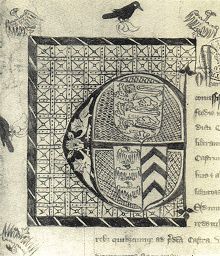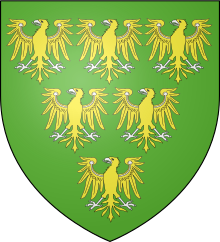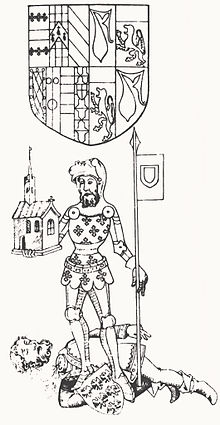Piers Gaveston, 1st Earl of Cornwall
Piers Gaveston, 1st Earl of Cornwall (* around 1284 , † June 19, 1312 near Warwick ) was a nobleman from France. He was the favorite and possibly a lover of King Edward II of England .
origin
Piers Gaveston came from Gascony, which was then part of England . He was a younger son of the knight Arnaud de Gabaston , who had served the English King Edward I in many campaigns as a soldier, and of Claramonde de Marsan . Allegedly he was about the same age as Prince Edward, who was born in 1284, but since he took part in the campaign to Flanders as early as 1297 , he was probably born around 1280.
Rise in the wake of the heir to the throne
In 1297 Gaveston served in the English army in Flanders , after which he served at the English royal court. In 1300 he took part in the campaign of King Edward I against Scotland like his father and older brother Arnaud-Guillaume de Marsan . Towards the end of the year he belonged to the court of the heir apparent Eduard. According to one contemporary chronicle, King Edward I was impressed by Gaveston's courtly manners, and according to another chronicle he was elegant, astute, and cultured, but also militarily skilled. Gaveston could have been commissioned by the king himself to serve as a model for the heir to the throne. Gaveston quickly won the heir's favor and became a close friend of his. The proximity to the prince brought Gaveston many advantages, but was also a risk when he was banned from court in June 1305 after a dispute with the treasurer Walter Langton . Gaveston and the young Gilbert de Clare were themselves temporarily banished from the prince's court. It was only in October 1305, the king again reconciled with his son, and the following spring the heir apparent was facing another expedition to Scotland as a Knight of the Bath to beat Knight . Four days later, on May 26, 1306, Gaveston was beaten to the Knight of the Bath along with numerous other young men. Instead of taking part in the campaign against Scotland, however, the young knights traveled to France and took part in a tournament there. The king first ordered the deserters to be arrested and their estates confiscated. In January 1307 they were pardoned on the intercession of Queen Margarethe . Nevertheless, shortly afterwards, on February 26, 1307, Gaveston was first exiled, presumably because the king disapproved of the close relationship between him and the heir to the throne. Gaveston must have left England before April 30th, but the exile was probably more a punishment for the heir to the throne than for Gaveston, for Gaveston received a substantial annual pension of 100 marks during his exile in Gascony .

Favorite of the young king
According to contemporary chronicles, the Prince of Wales's relationship with Gaveston was excessive, dissolute, and immeasurable, and it was generally believed that the two had a homosexual relationship. This is considered controversial today, and the thesis is also put forward that the relationship was not shaped sexually, but rather a close fraternal relationship. According to the documents received, both conclusions are possible. The fact was undoubtedly that in early 1307 the young heir to the throne was more closely connected to Gaveston than any other person. This close bond had far-reaching consequences for both partners and for the entire empire. Almost immediately after the death of King Edward I in July 1307, his son and successor lifted his friend's exile. Gaveston was made Earl of Cornwall on August 6, 1307 , a title most recently reserved to royal princes, and received almost all of the estate of Edmund , the last Earl of Cornwall, who died in 1300 . The certificate of appointment could possibly have been written later and then postdated, because it bears the combined coat of arms of Gaveston and his future wife Margaret de Clare , whom he only married on November 1, 1307. The charter was testified by seven of the eleven English earls at the time, a sign that these magnates initially consented to the levy of Gaveston. Against the rapid rise and the marriage of the royal favorite with a niece of the king, who belonged to the powerful Clare family , there was increasing resistance among the English barons. A tournament is said to have contributed to this, in which Gaveston and his entourage defeated the Earls of Arundel , Hereford and Warenne on December 2, 1307 . At least Warenne resented Gaveston's victory, thus establishing his hostility to Gaveston.
Before traveling to France to marry the French princess Isabella, the king appointed Gaveston as regent for England on December 26, 1307. Although Gaveston did not abuse this office, many contemporaries resented this act of royal favoritism over the other magnates. During the coronation of Edward and Isabella on February 25, 1308, Gaveston played a prominent role. He immediately followed the king and was allowed to wear the Edwardian crown . To do this, he loosened the Curtana sword from his belt and attached the spurs to Edward's left foot. His sumptuous clothes and behavior during the banquet that followed are said to have so indignant and insulted the Queen's French relatives, Karl von Valois and Louis d'Evreux , that they left the banquet indignant.
Increasing conflict with the barons
After the barons had already expressed their dissatisfaction with the government of King Edward II in the Boulogne Agreement in January 1308 , there was an open riot against Gaveston's position at court in the spring of 1308. Their criticism was directed less against his political influence and more against his lavish lifestyle at the king's expense and against his arrogance. Under the leadership of the eldest of the Earls, Henry de Lacy, 3rd Earl of Lincoln , the aristocratic opposition appeared in Parliament in April 1308 . The barons presented the king with three articles with their demands, including the banishment of Gaveston, which threatened civil war. Except for the Earls of Lancaster and Richmond and a few knights of the court such as the elder Despenser , Gaveston had little support. The aristocratic opposition, on the other hand, had the support of King Philip IV of France, the queen's father. King Edward II therefore had to give in to the demands of the barons on May 18. Gaveston must have left the Empire by June 24th, and Archbishop Robert Winchelsey of Canterbury threatened excommunication if he returned .
Despite the opposition of the barons, King Edward II tried to make Gaveston's return possible immediately after the exile began. On June 16, he appointed him King's lieutenant in Ireland , although Richard Og de Burgh, 2nd Earl of Ulster, had only received this office the day before. Unlike de Burgh, Gaveston was given the power to replace royal officials in Ireland with men of his choice at will. For this he was allowed to use the income from vacant church property. The exile, originally planned by the magnates as a humiliation for Gaveston, now became an opportunity for him to exercise actual power. Gaveston exercised his office in Ireland cautiously, so that there were no complaints about his administration, but above all undertook a successful campaign in the Wicklow Mountains . In the spring of 1309, the king managed to have Gaveston's exile lifted. When he returned to England, however, he continued to be arrogant towards the other magnates. He mocked them with offensive nicknames like Thomas of Lancaster as fiddler (violinist or swindler), Aymer de Valence, 2nd Earl of Pembroke as Joseph the Jew and Guy de Beauchamp, 10th Earl of Warwick as Black Dog of Arden .
Due to the growing opposition of his barons, the king had to approve the election of Lords Ordainers on March 16, 1310 , a group of prelates and barons who were empowered to draft reform proposals, the so-called ordinances , for the benefit of the court and the empire . King Edward II tried to reduce the consequences of this surrender by campaigning against Scotland from 1310 to 1311. On October 1, 1310, he appointed Gaveston Justice of the Forest North of Trent and administrator of Nottingham Castle , which was in clear contradiction to the ordinances issued by the Lords Ordainer . Gaveston spent the winter in Roxburgh , but in January 1311 he pursued the Scottish King Robert I to Perth . The Scots, however, avoided a battle against the superior English troops. Although Gaveston had been made King's lieutenant in Scotland in July 1311 , he spent August in Bamburgh Castle in northern England to await the outcome of the confrontation between the King and the Lords Ordainer.
Fall and death
The king lost the conflict with the Lords Ordainer and had to agree to a third exile of Gaveston. According to paragraph 20 of the Ordinances of 1311 , Gaveston should not only be banned from England, but from all English possessions, including Ireland and Gascony. Under threat of excommunication he should have left Dover from England before November 1, 1311 . But the king and his friend did not adhere to these requirements either. Presumably Gaveston had not left England at all, because on January 13, 1312 he met the king at Knaresborough Castle , from where they went to York . This daring behavior can be explained by the birth of Gaveston's daughter, who was born in York around this time. Gaveston had his daughter baptized in the Franciscan Church in York on January 20, after the king had announced the return of Gaveston and his reinstatement in office on January 18.
According to the ordinances of the Ordinances, Gaveston was excommunicated by Archbishop Winchelsey in March. The nobility opposition under the Earl of Lancaster assembled an army to arrest the king and his favorite. On April 5, the king and his favorite narrowly escaped a force under Lancaster, Henry Percy and Robert de Clifford in Newcastle , whereupon they parted. The king returned to York while Gaveston retired to Scarborough Castle . There he was besieged by Pembroke, Warwick, Percy and Clifford until he agreed to negotiations on May 19. He was prepared to surrender, on condition that he could return to Scarborough, if an understanding between the king and the barons was not reached by August 1st. Pembroke, Percy, and Clifford vouched for his safety.
After an initial meeting in York, Gaveston was taken into custody by Pembroke, who took him south. On June 9th he was housed in the Rectory at Deddington in Oxfordshire while Pembroke was en route to his Bampton estate . On the morning of the next day, Warwick seized Gavestons and took him to Warwick Castle . After brief consultations between Warwick, Lancaster and Hereford, they decided to execute Gaveston. On June 19, 1312, they took him to the Kenilworth Road . On Blacklow Hill , who was already on the property of Lancaster, Gaveston was beheaded . His body was taken to the Dominican Convent of Oxford, where it was kept for over two years before King Edward II had him interred on January 2, 1315 in the Dominican Convent of Kings Langley .
Offspring and aftermath
Gaveston's daughter Joan was taken to Amesbury Convent . It was with John Multon, a son of Thomas de Multon, Lord of Egremont engaged, but died before the wedding in 1325. Probably had Gaveston with Amice de Gavaston even a second, illegitimate daughter, who later maid of honor of Queen Philippa of Hainault , the Wife of King Edward III. has been. In 1338 she married John Driby , a courtier in the king’s entourage or his sons John of Gaunt and Lionel of Antwerp, 1st Duke of Clarence .
Although King Edward II did not take immediate action against the murderers of his favorite, he did not forgive them. The execution of Gaveston permanently strained the relationship between the king and his leading barons and had a decisive influence on the further reign of King Edward II. Gaveston's widow Margaret married Hugh de Audley in 1317 , who together with Roger Damory became one of the new royal favorites. However, they were ousted by Hugh le Despenser around 1318 , who won the favor of King Edward II, whereupon serious arguments broke out again between the barons and the king, which ultimately led to the king's deposition and murder.
literature
- Gaveston, Piers . In: Encyclopædia Britannica . 11th edition. tape 11 : Franciscans - Gibson . London 1910, p. 539 (English, full text [ Wikisource ]).
- Edward Maunde Thompson : Gaveston, Piers . In: Leslie Stephen (Ed.): Dictionary of National Biography . Volume 21: Garnett - Gloucester. , MacMillan & Co, Smith, Elder & Co., New York City / London 1890, pp. 76 - 78 (English).
- JS Hamilton: Gaveston, Piers, earl of Cornwall (d.1312). In: Henry Colin Gray Matthew, Brian Harrison (Eds.): Oxford Dictionary of National Biography , from the earliest times to the year 2000 (ODNB). Volume 21: Freud – Gibberd. Oxford University Press, Oxford 2004, ISBN 0-19-861371-7 , ( oxforddnb.com license required ), as of January 2008
Web links
- Piers Gaveston, 1st Earl of Cornwall on thepeerage.com
Individual evidence
- ^ William Arthur Shaw: The Knights of England. Volume 1, Sherratt and Hughes, London 1906, p. 111.
- ^ William Arthur Shaw: The Knights of England. Volume 1, Sherratt and Hughes, London 1906, p. 112.
- ↑ Pierre Chaplais: Piers Gaveston. Edward II's Adoptive Brother. Clarendon Press, Oxford 1994, ISBN 978-0-19-820449-7 , p. 21.
| personal data | |
|---|---|
| SURNAME | Gaveston, Piers, 1st Earl of Cornwall |
| BRIEF DESCRIPTION | Nobleman, favorite of King Edward II. |
| DATE OF BIRTH | around 1280 |
| DATE OF DEATH | June 19, 1312 |
| Place of death | at Warwick |



